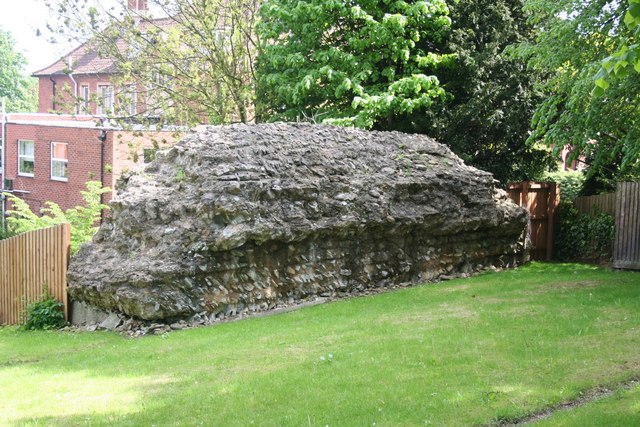Newport Arch on:
[Wikipedia]
[Google]
[Amazon]
Newport Arch is a 3rd-century Roman gate in the Newport district of the city of Lincoln in
 From ''Romano-British Buildings and Earthworks'' by John Ward (1911):
From ''Romano-British Buildings and Earthworks'' by John Ward (1911):
Lindum
General information on Roman Lincoln and inscriptions
Not resting on their laurels
A survey of Lincoln's Roman heritage Buildings and structures completed in the 3rd century Buildings and structures in Roman Britain Buildings and structures in Lincoln, England Gates in England Grade I listed buildings in Lincolnshire Grade I listed gates Ruins in Lincolnshire History of Lincoln, England Arches and vaults in England Roman sites in Lincolnshire
Lincolnshire
Lincolnshire (), abbreviated ''Lincs'', is a Ceremonial counties of England, ceremonial county in the East Midlands and Yorkshire and the Humber regions of England. It is bordered by the East Riding of Yorkshire across the Humber estuary to th ...
, England. It is a Scheduled monument
In the United Kingdom, a scheduled monument is a nationally important archaeological site or historic building, given protection against unauthorised change.
The various pieces of legislation that legally protect heritage assets from damage, visu ...
and Grade I listed building
In the United Kingdom, a listed building is a structure of particular architectural or historic interest deserving of special protection. Such buildings are placed on one of the four statutory lists maintained by Historic England in England, Hi ...
and is reputedly the oldest arch in the United Kingdom still used by traffic.
History
The arch was remodelled and enlarged when the city, then the Roman townLindum Colonia
Lindum Colonia was the Roman settlement which is now the City of Lincoln in Lincolnshire. It was founded as a Roman Legionary Fortress during the reign of the Emperor Nero (58–68 AD) or possibly later. Evidence from Roman tombstones ...
, became capital of the province Flavia Caesariensis in the 4th century. Though unique in the United Kingdom, it is nevertheless one of many original Roman arches still open to traffic, other examples being two gates through the city walls of the Roman town of Diocletianopolis (now Hisarya, Bulgaria), as well as numerous examples in Anatolia
Anatolia (), also known as Asia Minor, is a peninsula in West Asia that makes up the majority of the land area of Turkey. It is the westernmost protrusion of Asia and is geographically bounded by the Mediterranean Sea to the south, the Aegean ...
.
As the north gate of the city, it carried the major Roman road Ermine Street
Ermine Street is a major Roman road in England that ran from London (''Londinium'') to Lincoln ('' Lindum Colonia'') and York ('' Eboracum''). The Old English name was ''Earninga Strǣt'' (1012), named after a tribe called the ''Earninga ...
northward almost in a straight line to the Humber
The Humber is a large tidal estuary on the east coast of Northern England. It is formed at Trent Falls, Faxfleet, by the confluence of the tidal rivers River Ouse, Yorkshire, Ouse and River Trent, Trent. From there to the North Sea, it forms ...
.
 From ''Romano-British Buildings and Earthworks'' by John Ward (1911):
From ''Romano-British Buildings and Earthworks'' by John Ward (1911):
:A considerable portion of the north gate of Lincoln — the Newport Arch — is standing, but is buried to the extent of about . in the soil and débris accumulated since Roman times. The structure is about deep and has a single passage for the road, wide. The inner or back portal of this passage is still intact, and is nearly in the clear and rises to a height of about above the Roman level. Its arch is of a single ring of large limestonevoussoir A voussoir ( UK: ; US: ) is a wedge-shaped element, typically a stone, which is used in building an arch or vault.“Voussoir, N., Pronunciation.” Oxford English Dictionary, Oxford UP, June 2024, https://doi.org/10.1093/OED/7553486115. Acces ...s rising from imposts which appear to have been moulded. The outer or front arch has long since disappeared. On the east side is a postern for pedestrians, . wide and contracting to about . at the north end, and . high from the Roman level. On the west side there was a similar postern about a century ago. The whole structure is of good masonry, and it appears to have projected considerably beyond the north face of the town wall.
Accidents
In May 1964 a goodslorry
A truck or lorry is a motor vehicle designed to transport freight, carry specialized payloads, or perform other utilitarian work. Trucks vary greatly in size, power, and configuration, but the vast majority feature body-on-frame constructio ...
belonging to the Humber Warehousing Company struck the arch while attempting to pass under it.
Forty years later, in May 2004, another lorry struck the arch, causing minor damage.
13 years later, in May 2017, a RASE logistics lorry got stuck underneath the arch; after letting down the tyres, it was able to reverse out with no apparent damage to the structure.
See also
*Jewry Wall
The Jewry Wall is a substantial ruined wall of 2nd-century Roman masonry, with two large archways, in Leicester, England. It stands alongside St Nicholas' Circle and St Nicholas' Church. It formed the west wall of a public building in (Ro ...
References
*External links
{{commons category, Newport ArchLindum
General information on Roman Lincoln and inscriptions
Not resting on their laurels
A survey of Lincoln's Roman heritage Buildings and structures completed in the 3rd century Buildings and structures in Roman Britain Buildings and structures in Lincoln, England Gates in England Grade I listed buildings in Lincolnshire Grade I listed gates Ruins in Lincolnshire History of Lincoln, England Arches and vaults in England Roman sites in Lincolnshire